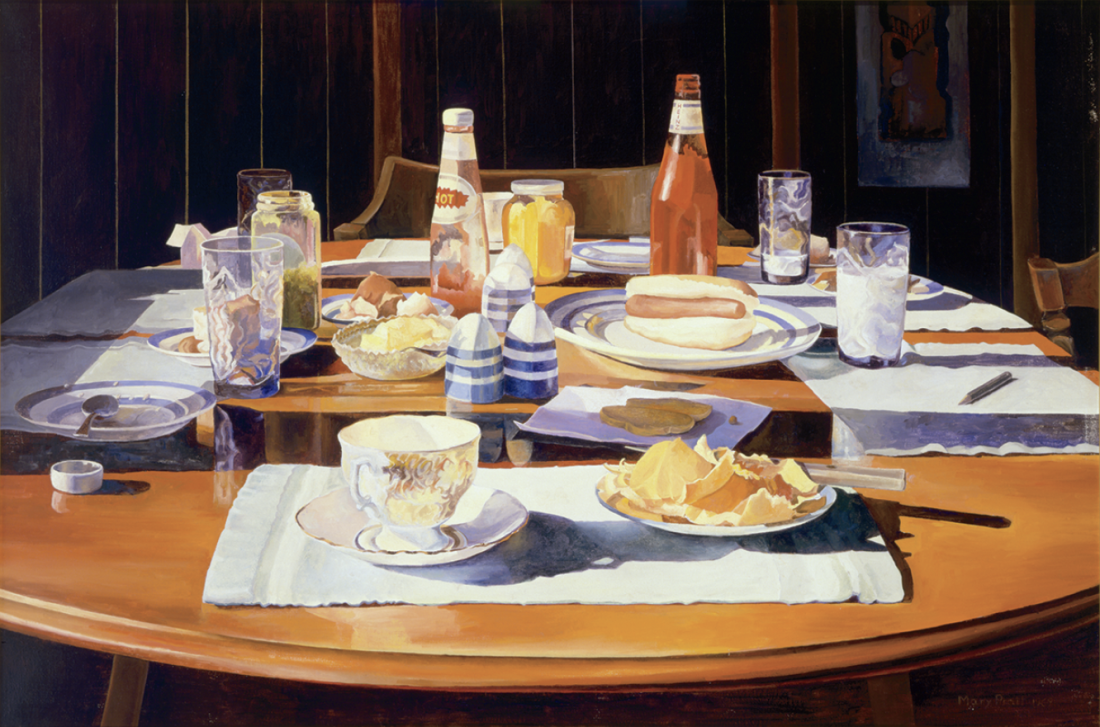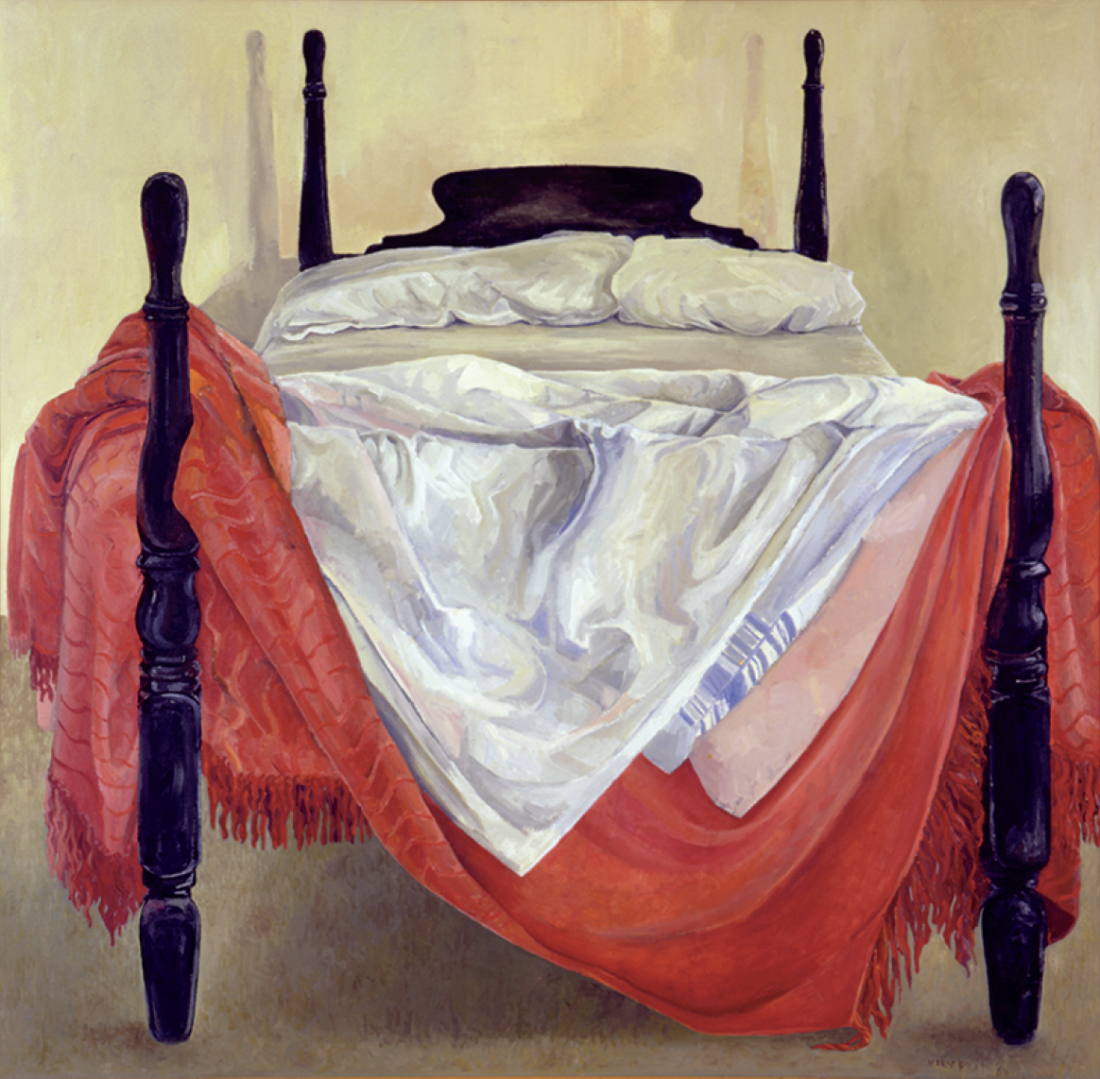Mary Pratt
Mary Pratt uses photographic projections when making paintings—she has done this for 44 years. The retrospective at The Rooms, St. John’s includes work from that whole period, arranged not chronologically, but as the gallery has it, displayed as “an interwoven conversation of themes.”
The first painting Mary Pratt made from a projected slide in 1969, Supper Table, is here. When looking back at this painting and the adoption of projection in her working procedure, Pratt described the camera as “an instrument of liberation.” The liberation was from observational drawing and composition—the time-consuming setting up of a painting, rather than its execution. Pratt wrote, “now that I no longer had to paint on the run I could pay each gut reaction its proper homage. I could use the slide to establish the drawing and concentrate on the light, the content, the symbolism.” That “on the run” indicates the liberation had also to do with time; Pratt had young children and the management of her working schedule, the postponement of painting until a suitable hour, now became available to her with the flick of a switch. This exhibition thoroughly establishes the relationships of Pratt’s work to her domestic life. Those relationships continue to offer a valuable prism through which to view her work, but the St. John’s exhibition also demonstrates the range in her work of translation from mechanically-produced images into painting.

Mary Pratt, Supper Table, 1969, oil on canvas, 61.0 x 91.4 cm. Collection of Mary Pratt. The Mary Pratt exhibition is a project by The Rooms Provincial Art Gallery, St. John’s, NL, and the Art Gallery of Nova Scotia, Halifax, NS, with support from the Government of Canada through the Department of Canadian Heritage, Museums Assistance Program, and also from the Canada Council for the Arts and the Government of Newfoundland and Labrador.
Supper Table is composed almost architecturally: a cluster of cruets, sculpted by a strong horizontal light, stand a block south of a ketchup tower. Everything has an appearance of solidity and permanence. It is a painting that elevates the detritus of an evening meal into something rather grand. Its antecedent might be Zurbarán’s Still Life with Pottery Jars—a painting surely made by employing a mirror or camera obscura. Pratt’s involvement with the optics of image-making conforms to a variety of practices that David Hockney, among others, has shown to be central to the history of art—using the available technology to interrogate the appearance of things. Taking photographs and projecting slides in order to generate paintings allows Pratt to investigate the visual complexity of the world around her. We can see her tackle precise characteristics of light when she renders luminosity in remarkable ways, in paintings like Fredericton (Waterloo Row) made in 1972 and Chocolate Birthday Cake from 1997.
Art historian Gerta Moray has described Pratt’s paintings as “openly acknowledging the photograph,” in fact, “acknowledging a relationship to commercial art through close-up and seductive presentation of objects…work that has a relationship to advertising magazines…to an invitation to desire and dream.” If Supper Table engages with photography in order to render the experience of a domestic scene, other paintings contextualize that experience in a different way; they remind us of other pictures, of particular kinds of photographs. With Pratt’s subject matter, the lighting and the depth of field appear specific to an idiom—that of commercial photography. In Red Grapes from 1996 or the uproarious Bowl’d Doultons (three dancing figurines, seen through glass), painted two years later, we see Pratt the art director, focusing on conjunctions of fruit or ceramic and glass, allowing, through a reference to the lens, the loss of that focus in the background.

Mary Pratt, Bedroom, 1987, oil on Masonite, 114.3 x 96.5 cm. Collection of the Right Honourable Adrienne Clarkson.
The scope of this exhibition provides an opportunity to examine shifts in Pratt’s work, to consider them in relation to various traditions and practices. There’s a pre-slide projection painting from the late ’60s here, The Bed, about which Pratt has written, “My gut reaction to the way it looked was so strong and erotic that I knew that if I didn’t have a physical connection to the image I was painting there would be no point in trying to paint it…to find, to feel…a major painting for me.” The Bed is urgent and erotic—a heavier paint surface than later work, a different pace, fugitive shadows on the wall. It is a painting to contrast with The Bedroom from 1987, a painting of considerable chromatic subtlety, but one made with what was, by then, a completely established projection procedure. The translation distances the viewer from her first-hand experience; it is a painting (as it should be within the chronology of Pratt’s work) that reminds us of advertising and magazines more than a wrecked, post-coital bed.
The dichotomy between the use of projection as an optical aid to make paintings that capture appearance (a minority of the works in the show, and responding to a tradition that might have reached its apotheosis with the work of Vermeer) and projection that associates art with modes of production and consumption (which reminds me of a much more recent cultural phenomenon, like Pop Art) is the issue raised by the exhibition.
Perhaps some resolution can be reached in considering her physical painting practice; a position can be found where the viewer can come to an understanding of the work that accommodates both Pratt as a student of optics and as a peruser of Bon Appétit. What is common to all the paintings here, including those of the figure, is the laborious nature of their execution, the painstaking work with tiny sable brushes, the artist sitting close up to a panel. To some extent, the paintings must be “about” such work; an equation between time and value is implicated, the one accruing through the expenditure of the other.

Mary Pratt, The Bed, 1968, oil on canvas, 91.4 x 91.4 cm. Private collection.
“Mary Pratt” was exhibited at The Rooms, St. John’s, Newfoundland, from May 11 to September 8, 2013. The exhibition will travel to the Art Gallery of Windsor, the McMichael Canadian Art Collection in Kleinburg, the MacKenzie Art Gallery in Regina, and the Art Gallery of Nova Scotia in Halifax.
Martin Pearce makes paintings and drawings. He teaches in the School of Fine Arts and Music at the University of Guelph.

